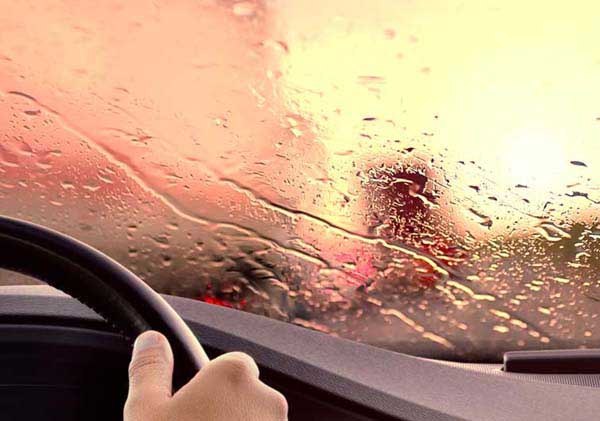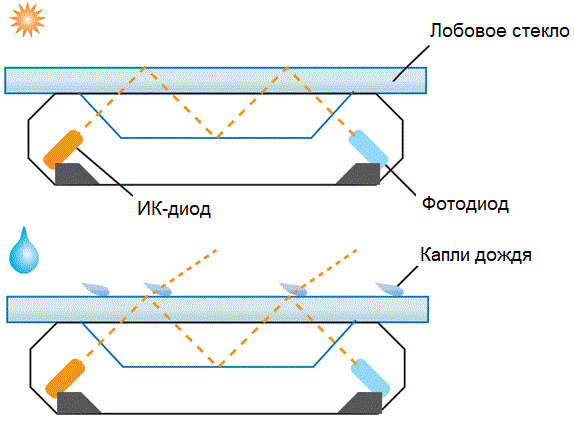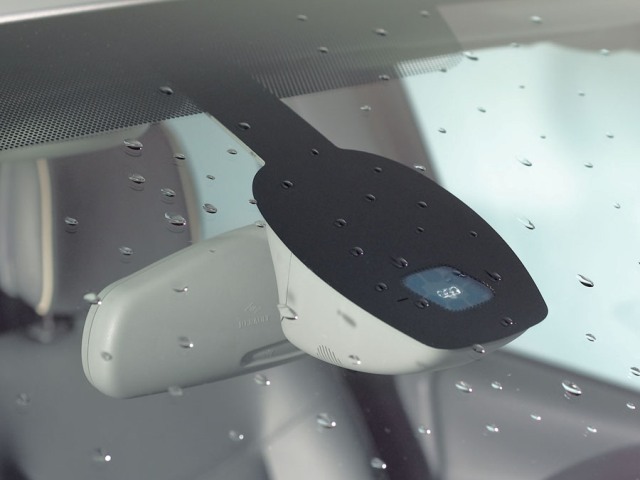Categories: Auto electrician
Number of views: 861
Comments on the article: 0
How the rain sensor works and works
The essence of the problem lies in the fact that precipitation and road dirt pose a threat (at least an obstacle) to the safe driving of the vehicle. In the end, it is simply not comfortable, and the driver himself would not want to be distracted by manually turning the wiper blades on and off, adjusting their operation, etc.
It is much better and more convenient if automation did this, and not the driver. Specialists have long been developing and improving systems to automate this process. And if earlier rain sensors were installed only on expensive cars, today they are available to almost everyone in the form of separate devices, and middle-class cars have recently often been equipped with them by default.

A rain sensor is installed inside the car opposite the windshield. Mounting is usually done directly to the rear view mirror housing. This sensor is an optical-electronic device of small dimensions that responds to glass wetting and controls the operation of wipers. Also, this sensor can control the inclusion of a washer, mechanisms for closing the hatch and door windows of the vehicle.
The principle of operation of the rain sensor is based on the reflection and refraction of optical radiation. Infrared rays are directed from the emitter to the photodetector, passing along the path through the transparent medium of the windshield. In the electronic circuit of the device, the refractive parameters of the infrared rays of the emitter are stitched for conditions of clean dry glass and wet or dirty glass.

When raindrops or pieces of dirt fall on the windshield at the point of reflection of the infrared rays of the sensor, the path of refraction of the rays changes. Electronics immediately responds to this by activating the wiper control mechanism, sets the proper mode and operating time of the wipers, depending on the amount of precipitation falling on the glass. At the right time, the cheeks will be automatically turned off again. Participation or attention is not required from the driver at all.
The sensitivity of the infrared photodetector is very high. It allows you to recognize small drops of water on the windshield, and transfer control to the automation for a couple of milliseconds. These features make it possible to automate the wiper control actions at a high level. Today there are also more advanced models of rain sensors that can turn on the washer when a sufficiently strong glass contamination is detected. The device is placed under the windshield so as not to interfere with the view of the driver and be in the range of the wiper blades.

The electronics of the rain sensor are pretty unsophisticated. In essence, it is a control unit and a relay. The control unit, as mentioned above, contains an optical electronic device that instructs the actuator to start the washer and wiper.
Being placed in a non-interfering view with a ventilated place (usually behind a rear-view mirror opposite the place that does not have glass defects and which wipers cover during their work), the sensor generally does not require attention from the driver. Of course, it is imperative that the brushes work reliably and properly, otherwise they will not clean the glass efficiently and will work for an unacceptably long time.
The actuator of the rain sensor is a relay unit, replacing a mechanical manual switch that controls the on and off of the washer and wiper. In addition, this unit protects the entire system from dynamic voltage changes in the electrics of the car due to interference.12 volt power is supplied to the sensor from the place provided for by the design of the car and its power supply.
Since the rain sensor works on the principle of radiation, reflection and refraction in the infrared spectrum, it is, of course, sensitive to low temperatures, and works a little longer in the frosty season. However, once the first drop appears on the glass in the zone of its operation, the automation will immediately begin its work.
See also at i.electricianexp.com
:
